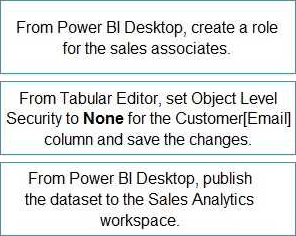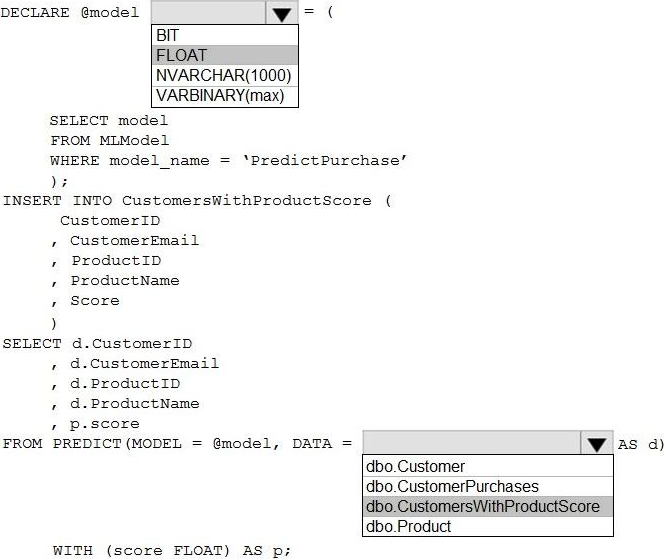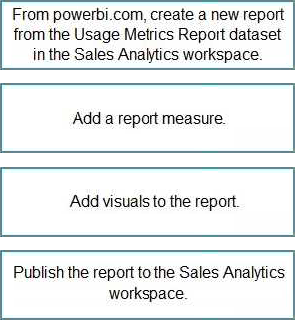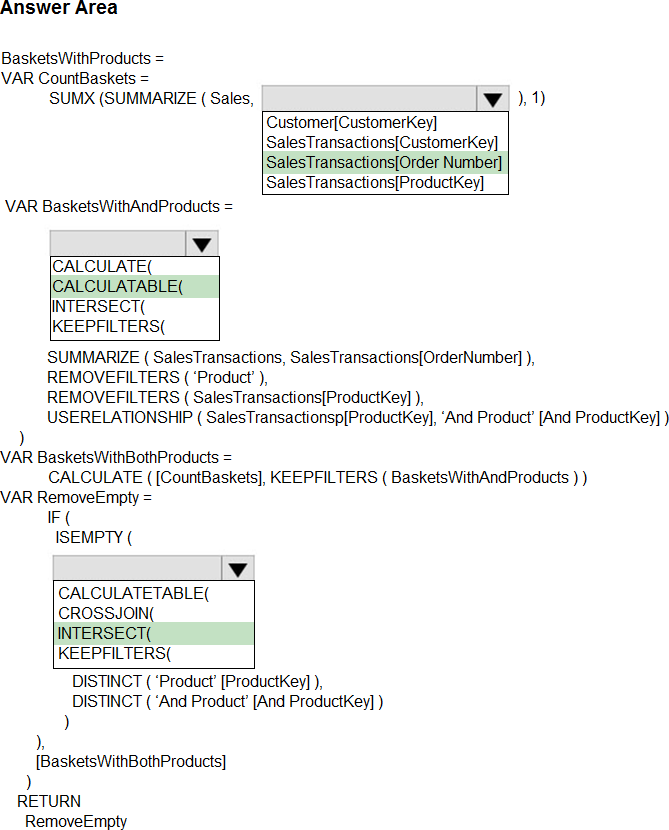Microsoft DP-500 Designing and Implementing Enterprise-Scale Analytics Solutions Using Microsoft Azure and Microsoft Power BI Online Training
Microsoft DP-500 Online Training
The questions for DP-500 were last updated at Jun 27,2025.
- Exam Code: DP-500
- Exam Name: Designing and Implementing Enterprise-Scale Analytics Solutions Using Microsoft Azure and Microsoft Power BI
- Certification Provider: Microsoft
- Latest update: Jun 27,2025
Topic 1, Litware, Inc.
Overview
Litware, Inc. is a retail company that sells outdoor recreational goods and accessories. The company sells goods both online and at its stores located in six countries.
Azure Resources
Litware has the following Azure resources:
• An Azure Synapse Analytics workspace named synapseworkspace1
• An Azure Data Lake Storage Gen2 account named datalake1 that is associated with synapseworkspace1
• A Synapse Analytics dedicated SQL pool named SQLDW
Dedicated SQL Pool
SQLDW contains a dimensional model that contains the following table.

SQLDW contains the following additional tables.

SQLDW contains a view named dbo.CustomerPurchases that creates a distinct list of values from dbo.Customer [customeriD], dbo.Customer
[CustomerEmail], dbo.ProductfProductID] and dbo.Product[ProductName].
The sales data in SQLDW is updated every 30 minutes. Records in dbo.SalesTransactions are updated in SQLDW up to three days after being created. The records do NOT change after three days.
Power BI
Litware has a new Power Bl tenant that contains an empty workspace named Sales Analytics.
All users have Power B1 Premium per user licenses.
IT data analysts are workspace administrators. The IT data analysts will create datasets and reports.
A single imported dataset will be created to support the company’s sales analytics goals. The dataset will be refreshed every 30 minutes.
Analytics Goals
Litware identifies the following analytics goals:
• Provide historical reporting of sales by product and channel over time.
• Allow sales managers to perform ad hoc sales reporting with minimal effort.
• Perform market basket analysis to understand which products are commonly purchased in the same transaction.
• Identify which customers should receive promotional emails based on their likelihood of purchasing promoted products.
Litware plans to monitor the adoption of Power Bl reports over time. The company wants custom Power Bl usage reporting that includes the percent change of users that view reports in the Sales Analytics workspace each month.
Security Requirements
Litware identifies the following security requirements for the analytics environment:
• All the users in the sales department and the marketing department must be able to see Power B1 reports that contain market basket analysis and data about which customers are likely to purchase a product.
• Customer contact data in SQLDW and the Power B1 dataset must be labeled as Sensitive. Records must be kept of any users that use the sensitive data.
• Sales associates must be prevented from seeing the CustomerEmail column in Power B1 reports.
• Sales managers must be prevented from modifying reports created by other users.
Development Process Requirements
Litware identifies the following development process requirements:
• SQLDW and datalake1 will act as the development environment. Once feature development is complete, all entities in synapseworkspace1 will be promoted to a test workspace, and then to a production workspace.
• Power Bl content must be deployed to test and production by using deployment pipelines.
• All SQL scripts must be stored in Azure Repos.
The IT data analysts prefer to build Power Bl reports in Synapse Studio.
DRAG DROP
You need to implement object-level security (OLS) in the Power Bl dataset for the sales associates.
Which three actions should you perform in sequence? To answer, move the appropriate actions from the list of actions to the answer area and arrange them in the correct order.

What should you configure in the deployment pipeline?
- A . a backward deployment
- B . a selective deployment
- C . auto-binding
- D . a data source rule
HOTSPOT
You need to populate the Customers With Product Score table.
How should you complete the stored procedure? To answer, select the appropriate options in the answer area. NOTE: Each correct selection is worth one point.
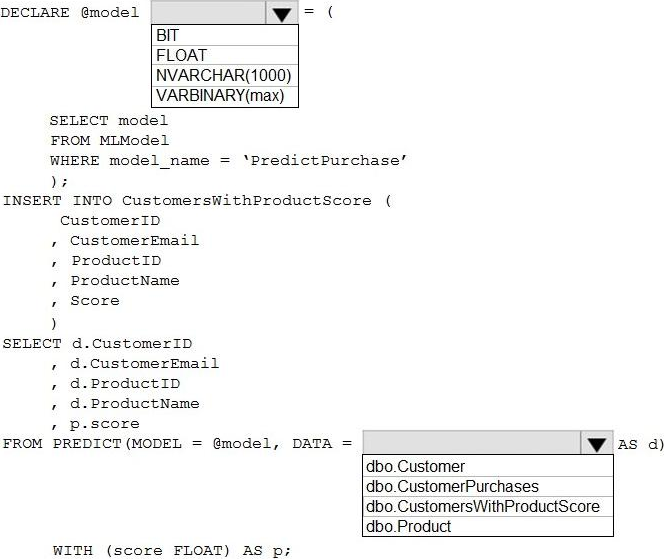
DRAG DROP
You need to create the customized Power Bl usage reporting. The Usage Metrics Report dataset has already been created. The solution must minimize development and administrative effort.
Which four actions should you perform in sequence? To answer, move the appropriate actions from the list of actions to the answer area and arrange them in the correct order.
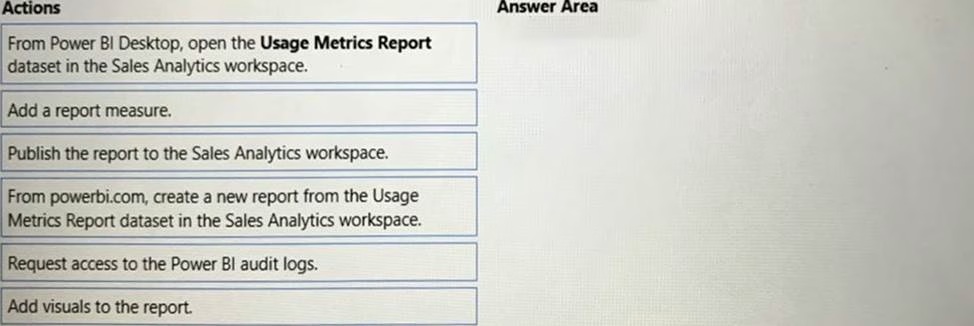
You need to configure the Sales Analytics workspace to meet the ad hoc reporting requirements.
What should you do?
- A . Grant the sales managers the Build permission for the existing Power Bl datasets.
- B . Grant the sales managers admin access to the existing Power Bl workspace.
- C . Create a deployment pipeline and grant the sales managers access to the pipeline.
- D . Create a PBIT file and distribute the file to the sales managers.
You need to recommend a solution to ensure that sensitivity labels are applied. The solution must minimize administrative effort.
Which three actions should you include in the recommendation? Each correct answer presents part of the solution. NOTE: Each correct selection is worth one point.
- A . From the Power Bl Admin portal, set Allow users to apply sensitivity labels for Power Bl content to Enabled.
- B . From the Power Bl Admin portal, set Apply sensitivity labels from data sources to their data in Power Bl to Enabled.
- C . In SQLDW. apply sensitivity labels to the columns in the Customer and Customers With Product Score tables.
- D . In the Power Bl datasets, apply sensitivity labels to the columns in the Customer and Customers With Product Score tables.
- E . From the Power Bl Admin portal, set Make certified content discoverable to Enabled.
How should you configure the Power BI dataset refresh for the dbo.SalesTransactions table?
- A . an incremental refresh of Product where the ModifiedDate value is during the last three days.
- B . an incremental refresh of dbo.SalesTransactions where the SalesDate value is during the last three days.
- C . a full refresh of all the tables
- D . an incremental refresh of dbo.SalesTransactions where the SalesDate value is during the last hour.
HOTSPOT
You need to create a measure to count orders for the market basket analysis.
How should you complete the DAX expression? To answer, select the appropriate options in the answer area. NOTE: Each correct selection is worth one point.
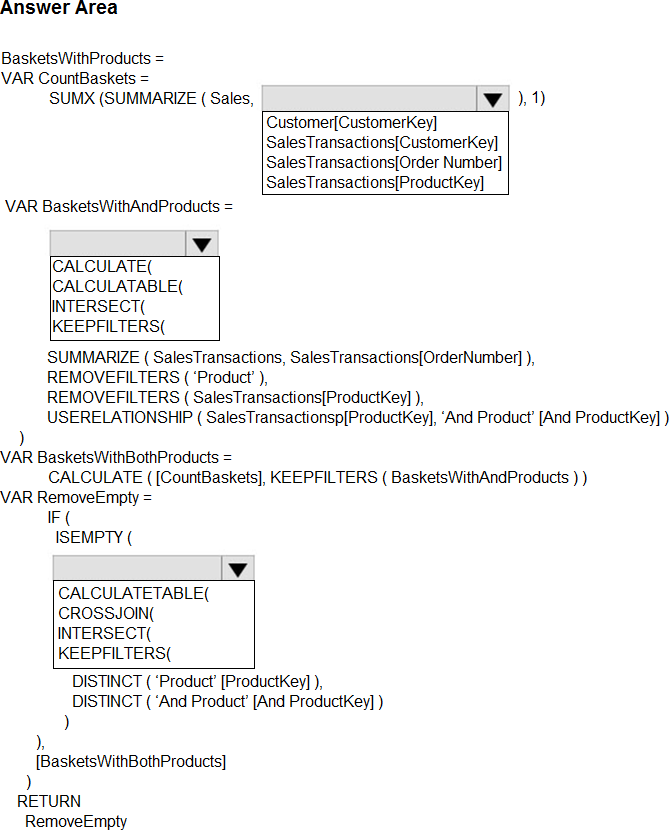
Topic 2, Contoso, Ltd
Overview
Contoso, Ltd. is a company that sells enriched financial data to a variety of external customers.
Contoso has a main office in Los Angeles and two branch offices in New York and Seattle.
Data Infrastructure
Contoso has a 50-TB data warehouse that uses an instance of SQL Server on Azure Virtual Machines.
The data warehouse populates an Azure Synapse Analytics workspace that is accessed by the external customers. Currently, the customers can access alt the data.
Contoso has one Power Bl workspace named FinData that contains a single dataset. The dataset
contains financial data from around the world. The workspace is used by 10 internal users and one external customer. The dataset has the following two data sources: the data warehouse and the Synapse Analytics serverless SQL pool.
Users frequently query the Synapse Analytics workspace by using Transact-SQL.
User Problems
Contoso identifies the following user issues:
• Some users indicate that the visuals in Power Bl reports are slow to render when making filter selections.
• Users indicate that queries against the serverless SQL pool fail occasionally because the size of tempdb has been exceeded.
• Users indicate that the data in Power Bl reports is stale. You discover that the refresh process of the Power Bl model occasionally times out
Planned Changes
Contoso plans to implement the following changes:
• Into the existing Power Bl dataset, integrate an external data source that is accessible by using the REST API.
• Build a new dataset in the FinData workspace by using data from the Synapse Analytics dedicated SQL pool.
• Provide all the customers with their own Power Bl workspace to create their own reports. Each workspace will use the new dataset in the FinData workspace.
• Implement subscription levels for the customers. Each subscription level will provide access to specific rows of financial data.
• Deploy prebuilt datasets to Power Bl to simplify the query experience of the customers.
• Provide internal users with the ability to incorporate machine learning models loaded to the dedicated SQL pool.
You need to recommend a solution to add new fields to the financial data Power Bl dataset with data
from the Microsoft SQL Server data warehouse.
What should you include in the recommendation?
- A . Azure Purview
- B . Site-to-Site VPN
- C . an XMLA endpoint
- D . the on-premises data gateway
You need to recommend a solution for the customer workspaces to support the planned changes.
Which two configurations should you include in the recommendation? Each correct answer presents part of the solution. NOTE: Each correct selection is worth one point.
- A . Set Use datasets across workspaces to Enabled
- B . Publish the financial data to the web.
- C . Grant the Build permission for the financial data to each customer.
- D . Configure the FinData workspace to use a Power Bl Premium capacity.
Latest DP-500 Dumps Valid Version with 83 Q&As
Latest And Valid Q&A | Instant Download | Once Fail, Full Refund

